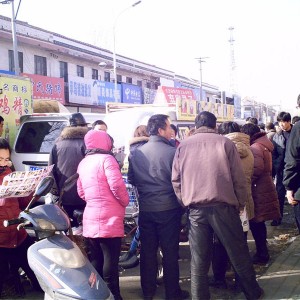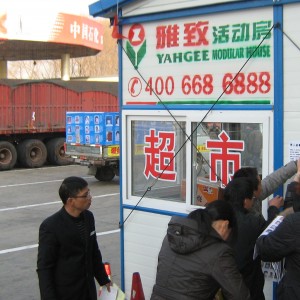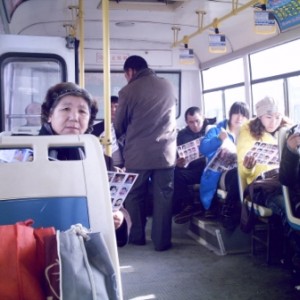(2) The Road Long, The Burden Heavy: Concluding Report of North China Anti-Child Trafficking Activities
Women’s Rights in China’s volunteer, Yiao Cheng All photos are by WRIC’s volunteers.

Pamphlet distributed on bus in Shan



Recent Child Rescue activities crossed vast rural areas north of the Yellow River, through five provinces, thirty counties and municipalities, totaling 3,000 kilometers. We distributed more than 60,000 pamphlets and other educational materials. We organized a dozen large pictorial exhibits. Our travels left impact on every hamlet, market, school and gas station we visited. On behalf of WRIC, I express my sincerest thanks to friends and media who supported us along the way. Thanks were also due for all the parent volunteers in the convoy, who during their time searching for their own children, also contributed to the cause of every family with a missing child.
Looking back at our recent project, we could be gratified for our successes and recognize our shortcomings. Here is a conclusion of some of these lessons.
First, we gathered systematic and somewhat comprehensive information about missing children in North China. Northern areas that were destinations of child trafficking were relatively scattered, contrary to the south. Poor rural areas dominated. Trades of human traffickers tended to happen in provincial border regions where law enforcement was lax. Northern families who bought children did so mainly for reasons of adding sons and child brides. The trend showed that the target of kidnapping were changing from boys dominating to more girl victims. Girls from age 7 to even teens were going missing. Although there could not be precise estimates on the numbers, cases that organizations in northern provinces had knowledge of were increasing exponentially. The child trafficking situation was deteriorating rapidly.
Secondly, recent activities alleviated the mood of many parents, and voided conflicts with the government. Northerners had straightforward tempers. Fruitless and frustrating searches often resulted in increasingly sharp conflicts with the government. As a result, child search activities and organizations could not receive any support or cooperation from governmental authorities. This conference and convoy emphasized measured interactions with the government. The conference proposed a bettering of relations with the government to the utmost of our ability. The suggestion to refrain from in-person petitions to Beijing was accepted by most attendees. We concluded that to root out the problem of child trafficking,
to reunite more children with their parents, the only hope rested largely with the government. During our travels we chose mostly rural routes. We had no conflict with local governments. Wherever they prohibited our assemblies, we would leave. We could not have our meeting in Zhenzhou, we held it in Xingxiang. We could not travel to Taiyuan, we went to Xi’an.
Thirdly, appropriate methods produced obvious results. Before, northern parent activists mainly acted on their own. Searching with limited funds in a country of this size had predicable results. Their economic situation could not but sink into difficulties. Our activities gave hope to everyone. Representatives all agreed with WRIC’s thinking and planned closer cooperation in the future, to use WRIC as a platform and maximize the potential of the internet for better efficiency. We hoped to be able to organize similar activities several times a year. When appropriate, northern parents could travel together to the south and vice versa. During this project, we receive much information about kidnapped children, including leads on dozens of cases that would be posted on WRIC after confirmation.
Finally, previous urban focus began to shift to rural area. Most kidnapped children were sold to villages. This project not only gathered information on kidnapped children, but also raised awareness of child trafficking problems among rural area residents. To see so many children missing and sold shocked many villagers. The tears of the parents and the care of volunteers moved many local residents deeply. Countless friendly locals donated, showed us directions and gave us case information. All the way through our travels, hotels and restaurants gave us discounts. Parking lots didn’t charge us a cent. Every place we went, as soon as we began to exhibit our posters, passersby began to help.
Our shortcomings were mainly a result of our insufficient preparation. Parents also gave many suggestions for improvement. Equipments were inadequately prepared. There were troubles with the cars, the loudspeakers, educational materials, et al.
This was the first time WRIC reached northern areas of the country. Our understanding of the local situation was not full. Our activities paled in comparison to the efforts of the parent volunteers. Credits to any success should mainly go to them. WRIC only did what it should do. We wish the parents success in finding their children, to fulfill their dreams of reunion of their families in the new year.

